
Darrington is a town in Snohomish County, Washington, United States. It is located in a North Cascades mountain valley formed by the Sauk and North Fork Stillaguamish rivers. Darrington is connected to nearby areas by State Route 530, which runs along the two rivers towards the city of Arlington, located 30 miles (48 km) to the west, and Rockport. It had a population of 1,347 at the 2010 census.

Granite Falls is a city in Snohomish County, Washington, United States. It is located between the Pilchuck and Stillaguamish rivers in the western foothills of the Cascade Range, northeast of Lake Stevens and Marysville. The city is named for a waterfall north of downtown on the Stillagumish River, also accessible via the Mountain Loop Highway. It had a population of 3,364 at the 2010 census.
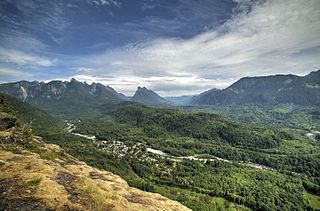
Index is a town in Snohomish County, Washington, United States. The population was 178 at the 2010 census.

Sultan is a city in Snohomish County, Washington, United States. It is located approximately 23 miles (37 km) east of Everett at the confluence of the Skykomish River and the Sultan River, a minor tributary. The city had a population of 4,651 at the 2010 census.

The Sauk River is a tributary of the Skagit River, approximately 45 miles (72 km) long, in northwestern Washington in the United States. It drains an area of the high Cascade Range in the watershed of Puget Sound north of Seattle. The river is a popular destination for fly fishing. It is a National Wild and Scenic River.

The Skykomish River is a 29-mile (47 km) long river in the U.S. state of Washington which drains the west side of the Cascade Mountains in the southeast section of Snohomish County and the northeast corner of King County. The river starts with the confluence of the North Fork Skykomish River and South Fork Skykomish River approximately one mile west of Index, then flowing northwesterly towards Puget Sound. It is joined by the Sultan River and the Wallace River at Sultan. It then meets the Snoqualmie River to form the Snohomish River at Monroe. The Snohomish River continues along the river valley eventually dumping into Port Gardner Bay on Possession Sound.
The Mountain Loop Highway is a highway in the U.S. state of Washington. It traverses the western section of the Cascade Range within Snohomish County. The name suggests it forms a full loop, but it only is a small portion of a loop, which is completed using State Routes 92, 9, and 530. Part of the highway is also a designated and signed Forest Highway, and is known as Forest Route 20.

Barlow Pass is a mountain pass on the west side of the Cascades in Washington on the Mountain Loop Highway between Silverton and Darrington. It is a popular trail head for access to the old mining town of Monte Cristo and has a branch off to hike up to Gothic Basin, which is about a mile in.
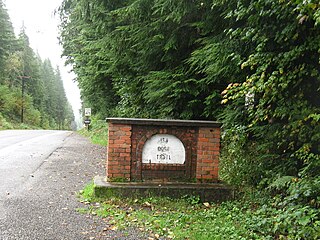
The Robe Canyon Historic Trail is a county park and hiking trail located east of Granite Falls, Washington. The park, maintained by Snohomish County, encompasses 970 acres (3.9 km2) of wilderness area along the Stillaguamish River and features railroad tunnels, river beaches, and hiking trails.

The Sultan River is a river in Snohomish County in the U.S. state of Washington. It is a tributary of the Skykomish River, which it joins at the town of Sultan, Washington. The river is dammed in its upper third by Culmback Dam to form Spada Lake.
The Scenic Subdivision or Scenic Sub is a railroad line running about 155 miles (249 km) from Seattle, Washington to Wenatchee, Washington. It is operated by BNSF Railway as part of their Northern Transcon. This route includes the Cascade Tunnel, as well as the 1893 site of the "last spike" near Scenic, Washington, which marked the completion for the Great Northern Railway transcontinental railway line built by James J. Hill.

The Tye River is a river in the U.S. state of Washington. It rises near Stevens Pass in the Cascade Mountains and flows west, joining the Foss River to form the South Fork Skykomish River. Its waters eventually empty into Puget Sound near Everett via the Skykomish River and Snohomish River. U.S. Route 2 follows the river's entire length. A BNSF Railway line follows most of the river except near the pass where the tracks use the Cascade Tunnel. Powerlines run by the Bonneville Power Administration (BPA) follow the Tye River west of Tunnel Creek.

The Beckler River is a tributary of the South Fork Skykomish River in the U.S. state of Washington in the United States.

Frederick Trump was a German–American barber, businessman, and patriarch of the Trump family.

The Whitehorse Trail is a rail trail in northern Snohomish County, Washington, connecting the cities of Arlington and Darrington. The 27-mile-long (43 km) trail uses a former Northern Pacific Railway spur built in 1901 and abandoned in 1990. The trail has been in development since the county government purchased it in 1993, with some sections open to the public.
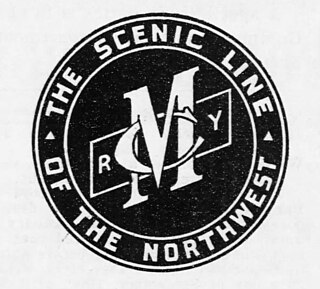
The Everett and Monte Cristo Railway was built to transport gold and silver ores from mines in the central Cascade Mountains to a smelter in Everett, Washington. After the first mining claims were staked in 1889, entrepreneurs began exploring the possibility of building a railroad to exploit the find. Construction began in April 1892 and the first train reached what became the town of Monte Cristo in August 1893. The mining boom ended in 1903. Poor ore quality and quantity played a role in the decline, but the failure of the railway to maintain service to Monte Cristo in the face of floods, landslides, winter snows, fires, and other disasters was also a factor in the collapse of the industry. Nonetheless, the railway hauled out approximately 300,000 tons of ore over the course of its operations.

Del Campo Peak is a prominent summit near the western edge of the North Cascades, in Snohomish County of Washington state. It is located south of Barlow Pass along the Mountain Loop Highway near the Monte Cristo area. It is situated on land administered by the Mount Baker-Snoqualmie National Forest. The mountain is named for a mining claim on the mountain's slope. The nearest peak is Gothic Peak, 0.5 miles (0.80 km) to the southwest, and Foggy Pass is the low point between the two peaks. Foggy Lake lies in Gothic Basin below the south face of Del Campo Peak and collects precipitation runoff which ultimately drains to South Fork Sauk River via Weden Creek. Runoff from the west side of the mountain drains into the Sultan River, and the north side drains into headwaters of the Stillaguamish River. In terms of favorable weather, the best months for climbing are July through September.

Sauk City, also known as Sauk, is a former unincorporated community in Skagit County, Washington. It was located along the Skagit River at its confluence with the Sauk River, west of the modern settlement of Rockport.
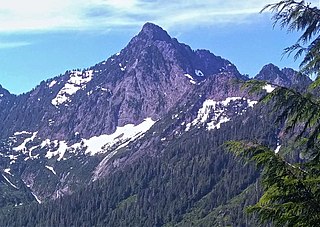
Hall Peak is a 5,484-foot (1,672-metre) mountain summit located in the South Fork Stillaguamish River Valley near the western edge of the North Cascades, in Snohomish County of Washington state. It is located 5 miles (8.0 km) northwest of Barlow Pass along the Mountain Loop Highway, near the Monte Cristo area, on land administered by the Mount Baker-Snoqualmie National Forest. Its nearest higher peak is Big Four Mountain, one mile to the south-southwest. Both mountains can be prominently seen from the Big Four picnic area, where the trail to the Big Four Ice Caves starts. The peak is named for mining prospector George Hall, who in 1891, discovered the Forty Five claim.
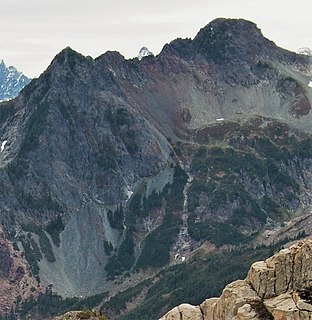
Silvertip Peak is a 6,140-foot (1,870-metre) mountain summit located in the North Cascades, in Snohomish County of Washington state. It is situated 3.5 miles south of Barlow Pass along the Mountain Loop Highway, in the Henry M. Jackson Wilderness, on land managed by Mount Baker-Snoqualmie National Forest. Precipitation runoff from the mountain drains north into tributaries of the Sauk River, or south into headwaters of Silver Creek which is a tributary of Skykomish River. Neighbors surrounding Silvertip include Gothic Peak, Del Campo Peak, Sheep Mountain, Cadet Peak, and Columbia Peak. Silver Lake and Poodle Dog Pass lie on the east flank of Silvertip, the Monte Cristo mining ghost town sits at the northeast base, and the Mineral City ghost town is at the southern foot of this peak. This peak was named in association with the nearby Silver Tip mining claim.























